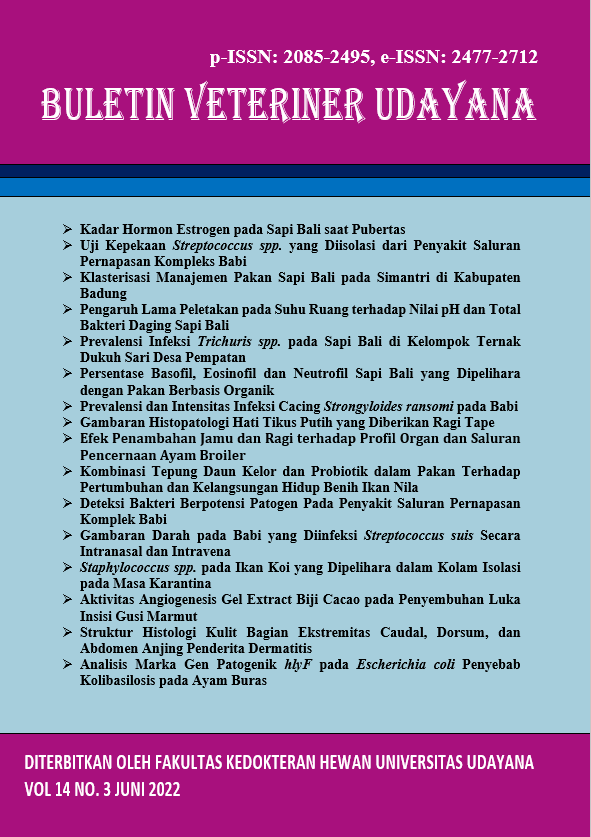DETECTION OF BACTERIA WITH POTENTIAL PATHOGENS IN PORCINE RESPIRATORY DISEASE COMPLEX
Abstract
This study aims to detect bacterial infectious agents in pigs with complex respiratory tract disease known as porcine respiratory disease complex (PRDC) in some pig herds in Bali and look for the right medication is use to handle the incidence. The research sample comes from Tabanan, Badung and Gianyar totaling 48 Samples were isolated and identified by methods: isolation, the primary test, biochemical test. Test of sensitivity to antibiotics using disc diffusion method according to Kirby-Bauer method. The result showed that bacterial agents isolated from pigs were among others Streptococcus spp. alfa hemolytic non-coagulase (41,6%), Staphylococcus spp. beta hemolytic noncoagulase (41,6%) and Escherichia coli. Staphylococcus spp. beta hemolytic non-coagulase and E. coli were sensitive to streptomycin, kanamycin, doxicyclin, clindamycin and bacitracin. To conclude, Streptococcus spp. alfa hemolytic non-coagulase were sensitive to streptomycin, kanamycin, clindamycin and bacitracin, but resisten to doxicyclin.
Downloads
References
Biberstein. 1990. Review of Veterinary Microbiology. Blackwell Scientific Publication. INC. Boston, Oxford, London, Edinburgh and Melbourne.
Blackall PJ, VJ Rapp-gabrielson and DJ Hampson. 1996. Serological characterization of H. parasuis isolated from Australian pigs. Aust. Vet. J. 73(3): 93-95.
Bochev I. 2007. Porcine respiratory disease complex (PRDC): A review. I. Etiology, epidemiology, clinical forms and pathoanatomical features. Bulg. J. Vet. Med. 10(3): 131-146.
Carter GR, JR Cole. 1990. Diagnostic Procedures in Veterinary Bacteriology and Mycology. 5th Ed. Academic Press. Inc Harcourt Brace Jovanovich, Publishers.
Dosen R, Prodanov J, Milanov D, Stojanov I, Pusic I. 2007. The bacterial infection of respiratory tract of swine. Biotechnol. Anim. Husb. 23(5-6): 237-243.
Koneman EW, Allen SD, VR Dowell VR, Sommers HM. 1994. Colour Atlas and Texboox of Diagnostic Microbiology, 9th Ed. J.B. Lippincott Company.
Lin BC. 2003. Identification and differentiation of Haemophilus parasuis sero-nontypeable strains using a species-specific PCR and the digestion of PCR products with Hind III endonuclease. Am. Assoc. Swine Vet. 299-301.
Loera-Muro VM, Loera-Muro A, Morfin-Mata M, Jacques M, Gonzales FJA, Ramirez-Castillo F, Ramirez-Lopez EM. 2014. Porcine respiratory pathogens in swine farm envirotment in Mexico. Open J. Anim. Sci. 4: 196-205.
Loera-Muro A, Ramirez-Castillo FY, Avelar-Gonzalez FJ, Guerrero-Barrera AL. 2015. Porcine respiratory desease complex and biofilms. J. Bacteriol. Parasitol. 6(6): 1-9.
Nicolet J. 1992. In Disease of Swine.7th Ed. Leman, A.D., B.E. Straw, W.L. Mengeling, S. Dallaire and D.J. Taylor (Eds). Iowa State University Press, Ames. Pp. 526-528.
Priadi A, Natalia L, Poernomo S. 2004. Penyakit Glasser’s pada babi di Pulau Batam, Propinsi Riau. JITV. 9(4): 266-272.
Thacker E, Thanawongnuwech R. 2002. Porcine respiratory disease complex (PRDC). Thai. J. Vet. Med. 32 (Suppl): 126-134.
Tulak A, Khaerunnisa, Landius. 2019. Strategi pengembangan peternakan babi di Distrik Hubikiak, Kabupaten Jayawijaya. J. Optima. 3(1): 91-102
Vecht U, HJ Wislink, JE van Dijk and HE Smith. 1992. Virulence of Streptococcus suis type 2 strain in newborn germfree pigs depends on phenotype infection and immunity. Am. J. Vet. Res. 60(2): 550-558.





